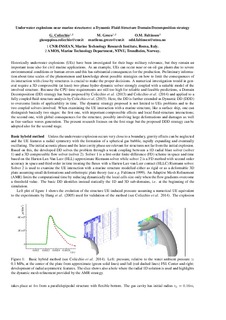| dc.contributor.author | Colicchio, Giuseppina | |
| dc.contributor.author | Greco, Marilena | |
| dc.contributor.author | Faltinsen, Odd Magnus | |
| dc.date.accessioned | 2018-05-09T12:27:18Z | |
| dc.date.available | 2018-05-09T12:27:18Z | |
| dc.date.created | 2016-10-24T14:49:43Z | |
| dc.date.issued | 2016 | |
| dc.identifier.isbn | 978-1-60785-381-7 | |
| dc.identifier.uri | http://hdl.handle.net/11250/2497814 | |
| dc.description.abstract | Historically underwater explosions (UEs) have been investigated for their huge military relevance, but they remain an important issue also for civil marine applications. As an example, UEs can occur near or on oil-gas plants due to severe environmental conditions or human errors and this has substantial consequences for the production. Preliminary information about time scales of the phenomenon and knowledge about possible strategies on how to limit the consequences of its interaction with close-by structures is crucial to make the proper decisions. A numerical investigation would in general require a 3D compressible (at least) two-phase hydro-dynamic solver strongly coupled with a suitable model of the involved structure. Because the CPU-time requirements are still too high for reliable and feasible predictions, a Domain Decomposition (DD) strategy has been proposed by Colicchio et al. (2013) and Colicchio et al. (2014) and applied to a fully coupled fluid-structure analysis by Colicchio et al. (2015). Here, the DD is further extended as Dynamic DD (DDD) to overcome limits of applicability in time. The dynamic strategy proposed is not limited to UEs problems and to the two coupled solvers involved. When examining the UE interaction with a marine structure, like a surface ship, one can distinguish basically two stages: the first one, with important compressible effects and local fluid-structure interactions; the second one, with global consequences for the structure, possibly involving large deformations and damages as well as free-surface waves generation. The present research focuses on the first stage but the proposed DDD strategy can be adopted also for the second stage. | nb_NO |
| dc.language.iso | eng | nb_NO |
| dc.publisher | University of Michigan | nb_NO |
| dc.relation.ispartof | Proceedings - 31st International Workshop on Water Waves and Floating Bodies | |
| dc.title | Underwater explosions near marine structures: a Dynamics Fluid Structure Domain-Decomposition strategy | nb_NO |
| dc.type | Chapter | nb_NO |
| dc.description.version | publishedVersion | nb_NO |
| dc.identifier.cristin | 1394103 | |
| dc.relation.project | Norges forskningsråd: 223254 | nb_NO |
| dc.description.localcode | Published by University of Michigan | nb_NO |
| cristin.unitcode | 194,64,20,0 | |
| cristin.unitname | Institutt for marin teknikk | |
| cristin.ispublished | true | |
| cristin.fulltext | original | |
